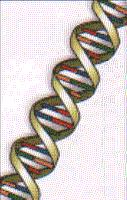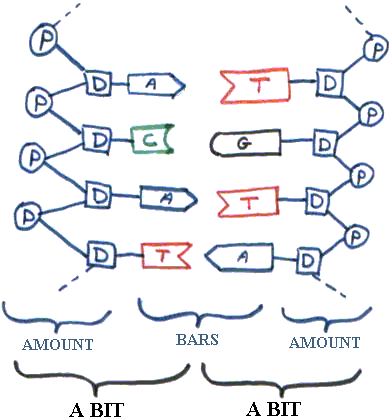Le coin des amatheurs de sciences version 2 
The sections of the site : The site  FORUM
FORUM  The space
The space  The genetics
The genetics  Medicine
Medicine  Physics
Physics  Tintin and science
Tintin and science  Ecology - Nuclear energy
Ecology - Nuclear energy  Mysteries of the history
Mysteries of the history  Humour
Humour  Diverse
Diverse
Le coin des amatheurs de sciences version 2 
The sections of the site : The site  FORUM
FORUM  The space
The space  The genetics
The genetics  Medicine
Medicine  Physics
Physics  Tintin and science
Tintin and science  Ecology - Nuclear energy
Ecology - Nuclear energy  Mysteries of the history
Mysteries of the history  Humour
Humour  Diverse
Diverse
The word which one more and more often hears in connection with the genetics are chromosome and DNA. What do they indicate exactly ?
 The chromosomes are contained in the cores of our cells. They contain our genetic inheritance. All the alive, animal or vegetable beings, have chromosomes, their variable number according to species. However, this number is always even : the chromosomes are assembled per pairs. The man has 23 pairs of chromosomes. Certain pairs are numbered from 1 to 22 (one often intends to speak about the pair 21 bus it is the cause of the majority of trisomies) and the last pair is called sexual chromosomes. Indeed, it is this pair which determines the sex of an individual. One distinguishes in this pair X chromosomes and Y. Each individual has X and either another X or a Y. Two X chromosomes gives a female, X and Y gives a male. The chromosomes appears as two branches, called chromatides, attached by the centromere (see drawing). The chromosomes are the head office of the DNA.
The chromosomes are contained in the cores of our cells. They contain our genetic inheritance. All the alive, animal or vegetable beings, have chromosomes, their variable number according to species. However, this number is always even : the chromosomes are assembled per pairs. The man has 23 pairs of chromosomes. Certain pairs are numbered from 1 to 22 (one often intends to speak about the pair 21 bus it is the cause of the majority of trisomies) and the last pair is called sexual chromosomes. Indeed, it is this pair which determines the sex of an individual. One distinguishes in this pair X chromosomes and Y. Each individual has X and either another X or a Y. Two X chromosomes gives a female, X and Y gives a male. The chromosomes appears as two branches, called chromatides, attached by the centromere (see drawing). The chromosomes are the head office of the DNA.
 The DNA (desoxyribonucleic acid) is a giant molecule (macromolecule) which is presented at the first level like a propeller, formed by two intertwined bits (see drawing) Each bit is in fact « a nucleotide » sequence which can be of four kinds : adenosine, cytidine, guanosine and thymidine. The nucleotides are assemblies of three components : desoxyribose (sugar), phosphoric acid, these two elements being common to four nucleotides, and a base nitrogenized among these four : adenine (noted A), cytosine (C), guanine (G), thymine (T). It can be connected thanks to connections between the phosphoric acid (noted P) and the desoxyribose (D).
The DNA (desoxyribonucleic acid) is a giant molecule (macromolecule) which is presented at the first level like a propeller, formed by two intertwined bits (see drawing) Each bit is in fact « a nucleotide » sequence which can be of four kinds : adenosine, cytidine, guanosine and thymidine. The nucleotides are assemblies of three components : desoxyribose (sugar), phosphoric acid, these two elements being common to four nucleotides, and a base nitrogenized among these four : adenine (noted A), cytosine (C), guanine (G), thymine (T). It can be connected thanks to connections between the phosphoric acid (noted P) and the desoxyribose (D).
It's the nitrogenized bases which make possible the two bits to be fixed. Indeed, there is a complementarity of the nitrogenized bases : A and T are able to be encased, C and G also, but no other assembly is possible. In more of fixing the two bits, this complementarity is the base of the genetic mechanisms (see the details in the other pages). A molecule of DNA can thus be schematized as follows :

One also speaks in genetics about genes and alleles. The genes are fragments of DNA. They code the manufacture of proteins (see The synthesis of proteins) and thus act on one of the characters of the individual. For example, there is a gene for the blood group, a gene for the color of the hair.... (actually, these characters are coded by many different genes, but let us not go into these details). As for the alleles, they are the various shapes of the same gene. Indeed, if we all are different, it is because the genes, which is common for us (we have a whole a gene for the blood group), can take several « values » which one calls alleles. For example, A and B are two alleles different from gene determining the blood group. Or if we compare DNA with our identity, the name corresponds to a gene and Smith corresponds to an allele (a possible value of the gene).